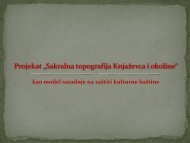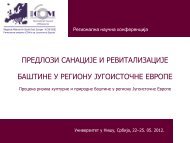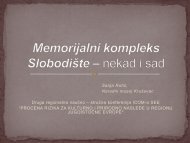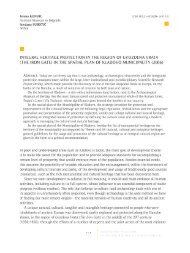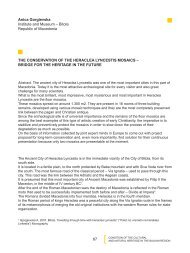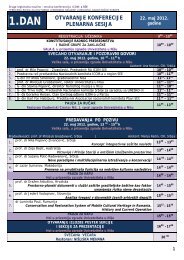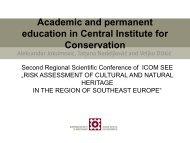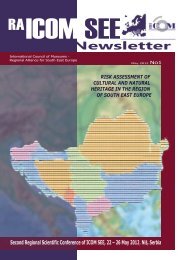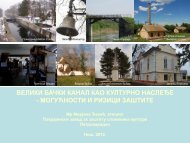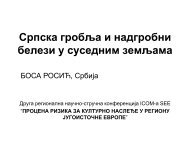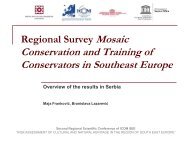Jana Šubic Prislan Nova Gorica Museum Slovenia THE ... - ICOM-SEE
Jana Šubic Prislan Nova Gorica Museum Slovenia THE ... - ICOM-SEE
Jana Šubic Prislan Nova Gorica Museum Slovenia THE ... - ICOM-SEE
Create successful ePaper yourself
Turn your PDF publications into a flip-book with our unique Google optimized e-Paper software.
as making the purchasing of equipment, specialised materials and tools from abroad much easier,as having the right equipment was one of the guarantees of professional work on the part of allthose involved. In 1992 the first programme for computerised conservation and restorationdocumentation was also created, which was replaced in 1998 by a more modern programmecalled Patina, which facilitated the unified management of conservation and restorationdocumentation for those who as yet did not have this facility within their own institution.We also participated in the drawing up of criteria for the obtaining of professional qualifications, asuntil 1992, when we replaced the title curator-conservator with conservator-restorer, we had had toadhere to the same criteria as curators. When dealing with problems connected with our status andorganisation, we looked for comparative situations in other countries. We forged the first contactswith our colleagues abroad when we took part in international gatherings and conferences, and ona few occasions also travelled (to Great Britain, Hungary and Italy) to learn things or at least to findout whether we were thinking along the right lines.In <strong>Slovenia</strong> we felt the lack of gatherings that would enable us to exchange knowledge, informationand opinions, at least informally, and so in 1995 we organised at the National <strong>Museum</strong> workshop aNew Year’s event, a practice which has continued to this day with meetings in different museumsaround <strong>Slovenia</strong>. We got to know our colleagues and their workshops and organised themedlectures. When post and telephone no longer provided sufficiently rapid access to information, wein 2001 “counted” and organised ourselves: all the employees of various workshops throughout<strong>Slovenia</strong> thus had a name and surname, we collected their addresses, phone numbers and e-mailaddresses and messages began to circulate – the same information came to every workshop.Nowadays this unifying role is played by the website of the Slovene Restoration Society, which forall of us represents an important, easily accessible source of information without which we wouldstill be trapped in attics and basements. That is also when we found out that 75 conservatorrestorerswere employed in museum workshops, of which over a half had secondary education andhad been subsequently trained for the job, while the rest had a university degree or a higherspecialisation, the latter in particular in the area of restoring works of visual arts, as this is a specialstudy programme at the Academy of Fine Arts. Considering that most museums are of a rathercomplex character, conservator-restorers have to work on all kinds of museum materials, mostoften on archaeological finds, the quantity of which has further increased in recent years, mainlydue to extensive excavations beneath the new Slovene motorway system. According to the latestunofficial data, the educational structure has improved, but the number of regularly employed hassadly remained the same. This is why it was necessary to strive for additional education of thoseemployed, while also giving young people a chance to obtain institutionalised education in theconservation and restoration of museum objects. In 1995, the first talks were held about theestablishment of a school for museum conservator-restorers, but it is only now, with theintroduction of the Bologna system, that we are about to get a study programme at this level at theRestoration Department of the Academy of Fine Arts. The door for university education relating tomuseums and archives is thus expected to open in the academic year 2012/13. In recent years thenumber of conservator-restorers with a degree or higher level of education in various specialistareas has been increasing, whereas the number of those spending a short period in institutionsabroad or attending courses organised by international organisations or foreign professionalassociations (<strong>ICOM</strong>, ICCROM) is lower.Wanting to acquire new knowledge, we actively participated in the work of related societies in<strong>Slovenia</strong> and helped shape their programme by including our content – let me mention here ourfirst appearance in connection with the Slovene <strong>Museum</strong> Society at the assembly of museum325[CONDITION OF <strong>THE</strong> CULTURALAND NATURAL HERITAGE IN <strong>THE</strong> BALKAN REGION



